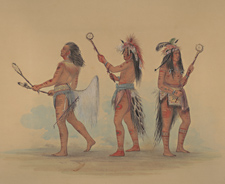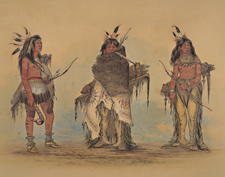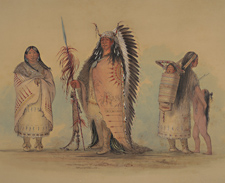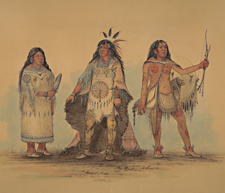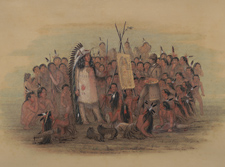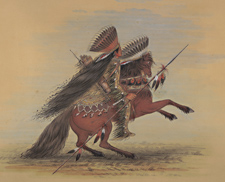
Vanished Worlds, Enduring People
Illustrated Works
George Catlin’s Album unique
George Catlin (1796-1872), a self-trained artist, was among the first painters who traveled west to record American Indian subjects and environments. His collection of paintings depicting native peoples and scenes, the largest of its kind, exposed multitudes of eastern Americans and Europeans to a new view of the American frontier and its inhabitants. Catlin started his artistic career as a painter of miniatures and portraits in Philadelphia, but his encounter with a delegation of Plains Indians changed his life. Impressed by these dignified individuals from a little-known part of the country, he vowed that "the history and customs of such a people, preserved by pictorial illustrations are themes worthy of the life-time of one man, and nothing...shall prevent me from visiting their country, and...becoming their historian."
Catlin launched his new career as a painter of Native Americans among the Iroquois. A portrait of the Seneca orator, Red Jacket, is his earliest known Indian work (1828). His great western adventure began in St. Louis; during the summers of 1830 to 1836, he ventured as far north as Fort Union in North Dakota. His output was astonishing. During his eighty-six days on the Upper Missouri River in 1832 alone, he painted more than 135 pictures.
Presenting his art to the public was a significant aspect of George Catlin’s work. His wildly popular “Catlin’s Indian Gallery” opened in New York in 1837, and later traveled to other venues, culminating in London in 1839. Financial problems forced him to sell his paintings in 1852, but he quickly set about recreating his art works from memory and notes. Although he painted Native American themes, Catlin practiced his art within the European conventions of his time. Once accepted as exact copies of their subjects, Catlin’s pictures are today viewed as images of native people veneered with European sensibilities.
George Catlin. Album unique. Brussels, 1863.
Catlin drew and redrew the images from his Indian Gallery, recreating at least 600 in a collection of oil paintings he called Cartoons. He also produced several smaller collections of sketches, or Albums uniques. Most of these albums contain ten to thirty uncolored sketches. Cornell’s album contains eleven original watercolors. The Crow chief shown here, Bada-ah-chondu (the Jumper), was first painted in a Minataree (Hidatsa) village on the upper Missouri, where both he and Catlin were visitors. Catlin reported that Bada-ha-chondu and his horse wore identical headdresses, “made of the quills [feathers] of the war-eagle and ermine skins.” Crow men were known for their long, shining hair.
George Catlin. “Bada-ah-chondu (the Jumper), Crow, ” from Album unique, 1863. Watercolor. [view]
George Catlin. “Ball Players: Tul-lock-chish-ko (He who Drinks the Juice of the Stone), Choctaw, Wee-chesh-ta-dooh-ta (the Very Red Man), Sioux, and Ah-no-je-nahge (He who Stands on Both Sides), Ojibwa, ” from Album unique, 1863. Watercolor. [view]
George Catlin. “Omaha Warriors: Nom-ba-mon-ye (Double Walker), Om-pa-ton-ga (Big Elk), and Man-sha-qui-ta (Little Soldier), ” from Album unique, 1863. [view]
George Catlin. “Sioux: Ee-ah-sa-pa (Black Rock), Wi-loo-tah-ee-tehash-ta-ma-nee (the Red Thing that Touches the Ground in Marching), daughter of Black Rock, and Oo-ton-nee (White Weasel), wife of Black Rock, ” from Album unique, 1863. Watercolor. [view]
George Catlin. “Minatarre: Eh-ah-chin-chee-a (Red Thunder), Eh-ah-ee-a-ee-a (?), Seet-see-be-a (Midday Sun), an unmarried girl, ” from Album unique, 1863. Watercolor. [view]
George Catlin. “Atelier Catlin”, from Album unique, 1863. Watercolor. [view]
